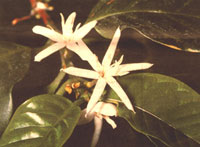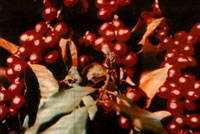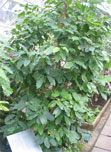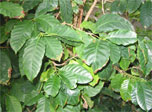|
|
||
This article was published before in the "Plantage Hortus" (December 1996) of the "Botanical Garden of Amsterdam"
by Fred Triep
| The coffee we drink is made from the beans of three species of the genus Coffea. This genus belongs to the family Rubiaceae. The Rubiaceae mainly include tropical and subtropical plants, but some plants from temperate regions. An European ancestry from this family is bedstraw. |
|
In this family, the leaves are opposite or in whorls. In addition the leaves often have stipules at the nodes. The flowers consist of 4 or 5 free sepals and four or five petals, with are grown together.
Besides Coffea, there are also other genera of this family, which result in useful products. From the species of the genus Cinchona is made, for example quinine and the genus Cephalis supplies emetic ipecacuanha. In addition some plants from this family provide dyes, such as Rubia (madder) and Uncaria (gambier).
There are three species of the genus Coffea which provide beans for the making of coffee. Those are the species of Coffea arabica (Arabian coffee), Coffea canephora (Congo coffee or coffee robusta) and Coffea liberica (Liberian coffee). The former type is the leading coffee supplier. The coffee produced in the world consist of 74% Arabic coffee and of 24% Robusta coffee, the rest of the coffee produced is Liberian coffee.
 |
Click on the thumbnail if you want to see the large picture Flowers of the coffee (Coffea arabica) Photo : hortusarchive |
Coffee plants are in culture 2 to 3 meters tall trees with shiny, oval-shaped leaves. In the wild they can be 4 to 6 meters high. Since picking at such a high tree presents problems, they are pruned in the culture. In the axils of the leaves arise 4 to 6 white (with C. arabica) or 60 (in C. robusta) flowers. After pollination there develop red berries, which contain two seeds (coffee beans). The berries ripen in 8 to 12 months, depending on the height, on which they are grown. Coffee bushes start blossoming from their third year and thereafter yhey can certainly produce beans for 10 years.
 |
Click on the thumbnail if you want to see the large picture Berries of coffee (Coffea arabica) Photo : Bob Ursem |
To eliminate the fruit pulp of the berries, there are two methods, one wet and one dry. In the dry method, after drying in the sun, the residues are mechanically removed. In the wet method, use is made of bacteria that ferment the wet pulp. The wet method is more laborious than the dry method, but delivers the best coffee on. Thereafter, the beans must be roasted, before they can be used for making coffee. What exactly happens during the burning of the beans is not yet fully understood, that has to do with the complexity of the coffee aroma. During roasting the beans lose protein and about 10 to 15 percent of the caffeine. In addition, sugars are caramelized, giving the coffee its brown color. The original coffee beans of C. arabica are in fact pale green.
The name coffee (and koffie, kaffee and cafe) is through the Turkish (qahve) derived from the Arabic word "quahwa", which meant "wine from berries." The biggest coffee supplier, C. arabica, is originally from Ethiopia, where it grew in the forested highlands. There the "wild" plant was not cultivated, that happened in Yemen between 1000 and 1300, where it was grown on irrigated terraces. Around the tenth century coffee was already discussed in the medical literature, but the intensive culture of this tree in Yemen took place only in the fifteenth century. From Yemen the coffee tree was spread across the world, where the Dutch played a major role in starting a coffee culture in Java from 1710.
Of the three species C. arabica grows the highest. He grows up to 600 to 1200 meters, but it is also grown at 1700 meters altitude in some countries. Due to the colder climate the maturing of the berries is delayed, which makes them eventually contain less moisture and more "flavor" than the coffee plant on lower areas. The other two species are found mainly in the lowlands. They require more warmth and precipitation, and the quality of their coffee is less. The Robusta coffee bean is therefore often used in instant coffee.
In February 2016, I visited a small
coffee plantation in Costa Rica. In the video below you can see how the coffee
culture takes place there. Rechts:
HD Video of the production of coffee on a small plantation in Monteverde
(Costa Rica)
Note:
During the
execution of the video, you can make the display fullscreen by clicking on the
symbol for
fullscreen at the right bottom. The
escape key will recover the thumbnail view.
Links
On the following web page you can find more information about coffee:
This page has been created on Monday
29 augustus 2016
![]()
For additions or reactions, send me an e- mail:
| Terug naar (return to): | Terug naar (return to): |


